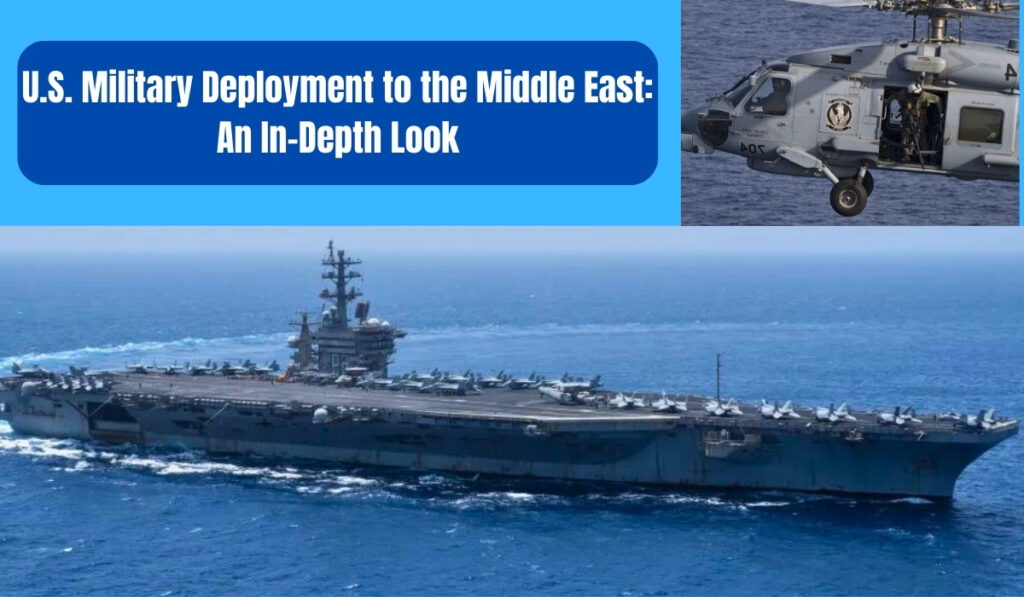Introduction
Military of the United States has announced the deployment of additional resources to the Middle East in response to the escalating tensions between Israel and Iran. This strategic move comes as a direct reaction to the recent surge in regional instability, including a series of high-profile assassinations that have significantly heightened the risk of a wider conflict.
The decision to bolster military presence in the region underscores the growing concern over the potential for increased hostilities, which could further destabilize the already volatile environment. By augmenting its military resources, the U.S. aims to provide additional support to its allies, deter any potential aggression, and ensure the protection of American interests and personnel in the region. This deployment includes a range of assets, such as naval vessels, aircraft, and specialized forces, intended to enhance operational capabilities and readiness.
The move reflects the serious nature of the current geopolitical situation and highlights the U.S. commitment to maintaining stability and security amid the escalating tensions between these two key regional players. The broader implications of this deployment could influence international diplomatic efforts and shape the strategic landscape in the Middle East for the foreseeable future.
Background and Context
Tensions between Israel and Iran have been rising, particularly after the recent assassinations of key figures linked to Hamas and Hezbollah, groups that have strong ties to Iran. These incidents have sparked fears of a widening conflict that could destabilize the region.
Key Events Leading Up to the Deployment
- Assassination of Ismail Haniyeh: On August 1, 2024, Hamas political chief Ismail Haniyeh was killed in Tehran. Haniyeh had been a prominent negotiator in ceasefire talks and was in Iran for the inauguration of the country’s new president.
- Killing of Fuad Shukr: On July 30, 2024, Fuad Shukr, a commander in Hezbollah, was killed in an Israeli airstrike in Beirut. Hezbollah has been actively involved in hostilities along the Lebanon-Israel border since the onset of the Gaza conflict in October.
U.S. Military Response
In response to these developments, the Pentagon announced several measures to bolster its military presence in the Middle East.
Key Deployments
- Aircraft Carrier: An aircraft carrier will be deployed to the region, providing a significant increase in air and naval power.
- Fighter Jet Squadron: An additional squadron of fighter jets will be sent to enhance aerial capabilities.
- Navy Cruisers and Destroyer Ships: These vessels will provide additional naval support and defense capabilities.
Pentagon spokesperson Sabrina Singh emphasized the dynamic nature of U.S. global defense, highlighting the capability to respond quickly to emerging threats. The deployment aims to protect U.S. forces in the region and support Israel’s defense.
Diplomatic Efforts and International Reactions
The United States has been actively engaging with Israeli officials to manage the situation and prevent further escalation.
Key Diplomatic Contacts
Call Between U.S. Secretary of Defense and Israeli Defense Minister: U.S. Secretary of Defense Lloyd Austin spoke with Israeli Defense Minister Yoav Gallant, reiterating U.S. support for Israel’s right to self-defense.
Conversation Between U.S. President and Israeli Prime Minister: U.S. President Joe Biden communicated with Israeli Prime Minister Benjamin Netanyahu, expressing continued support for Israel amidst the crisis.
Despite these measures, the Biden administration remains hopeful for a diplomatic resolution. Secretary Austin stated that there are still opportunities for diplomacy and that war is not inevitable.
Implications and Future Outlook
The U.S. military buildup is a clear signal of its commitment to Israel’s security. However, the situation remains precarious, with the potential for further escalation if retaliatory actions occur. The international community is closely watching the developments, as any significant conflict in the Middle East could have far-reaching consequences.
Conclusion
The United States’ decision to deploy additional military resources to the Middle East reflects the gravity of the situation and its commitment to regional stability. As tensions continue to rise, the world watches with bated breath, hoping for a peaceful resolution to prevent a larger conflict.
Sources
- Pentagon Announces Military Deployment
- Ismail Haniyeh Assassination Details
- U.S. and Israeli Diplomatic Efforts
- Hezbollah Commander’s Death in Beirut

